

History of Iceland. Iceland remained part of Denmark, but in keeping with the rise of nationalism around Europe in the nineteenth century an independence movement emerged.

The Althing, which had been suspended in 1799, was restored in 1844, and Iceland gained sovereignty after World War I, on 1 December 1918. However Iceland shared the Danish Monarchy until World War II. Although Iceland was neutral, the allies occupied it without resistance because of its strategic situation. Since Denmark was under Nazi occupation, Iceland declared itself a republic, and the Republic of Iceland was founded on 17 June 1944 as a fully independent nation. Following the Second World War Iceland was a founding member of the United Nations and grew rapidly, largely due to fishing, although this was marred by conflicts with other nations (Cod Wars).
Geological history[edit] Mid-Atlantic Ridge and adjacent plates. Early history[edit] Settlement (874-930)[edit] Irish monks[edit] Norse Discovery[edit] First settler[edit] History of Finland. The land area that now makes up Finland was probably settled immediately after the last ice age, which ended c. 9000 BC.
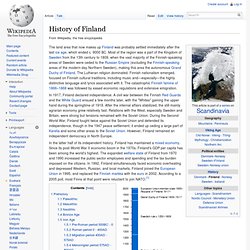
Most of the region was a part of the Kingdom of Sweden from the 13th century to 1809, when the vast majority of the Finnish-speaking areas of Sweden were ceded to the Russian Empire (excluding the Finnish-speaking areas of the modern-day Northern Sweden), making this area the autonomous Grand Duchy of Finland. The Lutheran religion dominated. Finnish nationalism emerged, focused on Finnish cultural traditions, including music and—especially—the highly distinctive language and lyrics associated with it. The catastrophic Finnish famine of 1866–1868 was followed by eased economic regulations and extensive emigration. In the latter half of its independent history, Finland has maintained a mixed economy.
History of Denmark. The history of Denmark dates back about 12,000 years, to the end of the last ice age, with the earliest evidence of human inhabitation.
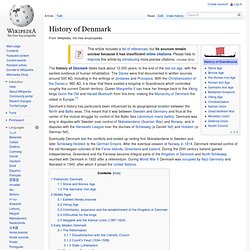
The Danes were first documented in written sources around 500 AD, including in the writings of Jordanes and Procopius. With the Christianization of the Danes c. 960 AD, it is clear that there existed a kingship in Scandinavia which controlled roughly the current Danish territory. History of Norway. The history of Norway has been influenced to an extraordinary degree by the terrain and the climate of the region.
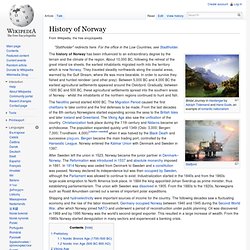
About 10,000 BC, following the retreat of the great inland ice sheets, the earliest inhabitants migrated north into the territory which is now Norway. They traveled steadily northwards along the coastal areas, warmed by the Gulf Stream, where life was more bearable. In order to survive they fished and hunted reindeer (and other prey). Gammalsvenskby. The former Swedish church in Gammalsvenskby.

St John's Lutheran parish church has been rebuilt and serves as an Orthodox church today. The location of the village in Ukraine. Verbivka (Standard Swedish: Gammalsvenskby, local Swedish dialect: Gammölsvänskbi; literally: "Old Swedish Village"; Ukrainian Старошведське, Staroshveds'ke; German Alt-Schwedendorf) is now part of the village of Zmiyivka (Ukrainian: Зміївка, Russian: Змеевка) in Beryslav Raion of Kherson Oblast, Ukraine which has a Swedish cultural heritage. Zmiyivka also includes three former villages settled by ethnic Germans. Historiesajten. Startsida. Medieval Scandinavian History - Vikings in the Middle Ages. Though notorious for their fearsome Viking raids, Scandinavians were also farmers and craftsmen.

Find out more about this complex society that began in Norway, Sweden and Denmark and spread to Iceland, Greenland, Russia, much of Europe and even the Americas. Medieval Atlas: Maps of ScandinaviaAn index of maps depicting Scandinavia, in whole or in part. Longship. Longships were sea vessels made and used by the Vikings from the Nordic countries for trade, commerce, exploration, and warfare during the Viking Age although scientific analysis of the oak timber shows at least one well known ship was built in Dublin, Ireland.
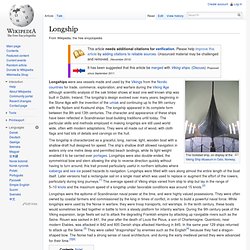
The longship’s design evolved over many years, beginning in the Stone Age with the invention of the umiak and continuing up to the 9th century with the Nydam and Kvalsund ships. The longship appeared in its complete form between the 9th and 13th centuries. The character and appearance of these ships have been reflected in Scandinavian boat-building traditions until today. The particular skills and methods employed in making longships are still used world wide, often with modern adaptations. VIKINGS. The term Viking though used to denote ship-borne explorers, traders and warriors, is actually a verb describing the acts of the Danes who originated in Denmark and raided the coasts of the British Isles, France and other parts of Europe from the late 8th century to the 11th century.
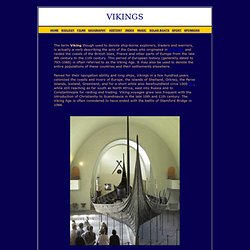
This period of European history (generally dated to 793–1066) is often referred to as the Viking Age. It may also be used to denote the entire populations of these countries and their settlements elsewhere. Famed for their navigation ability and long ships, Vikings in a few hundred years colonized the coasts and rivers of Europe, the islands of Shetland, Orkney, the Faroe Islands, Iceland, Greenland, and for a short while also Newfoundland circa 1000 [1], while still reaching as far south as North Africa, east into Russia and to Constantinople for raiding and trading. Viking voyages grew less frequent with the introduction of Christianity to Scandinavia in the late 10th and 11th century.
Germanic peoples. The Germanic peoples (also called Teutonic, Suebian or Gothic in older literature) are[1] an Indo-European ethno-linguistic group of Northern European origin, identified by their use of the Germanic languages which diversified out of Proto-Germanic starting during the Pre-Roman Iron Age.[2] The term "Germanic" originated in classical times, when groups of tribes were referred to using this term by Roman authors.
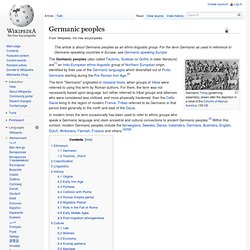
For them, the term was not necessarily based upon language, but rather referred to tribal groups and alliances who were considered less civilized, and more physically hardened, than the Celtic Gauls living in the region of modern France. Tribes referred to as Germanic in that period lived generally to the north and east of the Gauls.
Ethnonym Germanic The Latin ethnonym "Germani" seems to be attested in the Fasti Capitolini inscription for the year 222 BCE – de Galleis Insvbribvs et Germ(aneis) – where it may simply refer to "related" peoples, namely related to the Gauls. North Germanic languages. The North Germanic languages make up one of the three branches of the Germanic languages, a sub-family of the Indo-European languages, along with the West Germanic languages and the extinct East Germanic languages.
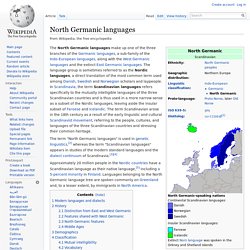
The language group is sometimes referred to as the Nordic languages, a direct translation of the most common term used among Danish, Swedish and Norwegian scholars and laypeople. In Scandinavia, the term Scandinavian languages refers specifically to the mutually intelligible languages of the three Scandinavian countries and is thus used in a more narrow sense as a subset of the Nordic languages, leaving aside the insular subset of Faroese and Icelandic. The term Scandinavian arose in the 18th century as a result of the early linguistic and cultural Scandinavist movement, referring to the people, cultures, and languages of the three Scandinavian countries and stressing their common heritage. Modern languages and dialects[edit] RUSSIA. The Church of Rome fell for its heresy; the gates of the second Rome, Constantinople, were hewn down by the axes of the infidel Turks; but the Church of Moscow, the Church of the New Rome, shines brighter than the sun in the whole universe...
Two Romes are fallen, but the third stands fast; a fourth there cannot be. Philotheos (Filofei), 1525, quoted by Colin Wells, Sailing from Byzantium, How a Lost Empire Shaped the World [Delta, Bantam Dell, 2007, p.277] I cannot forecast to you the action of Russia. It is a riddle, wrapped in a mystery, inside an enigma; but perhaps there is a key. That key is Russian national interest. Winston Churchill, October 1939 GEORGE SMILEY (ALEC GUINESS): "So how conscious is he? " Introduction. Gammalsvenskby. Ostrogoths. The Ostrogoths (Latin: Ostrogothi or Austrogothi) were a branch of the later Goths (the other major branch being the Visigoths). The Ostrogoths, under Theoderic the Great, established a kingdom in Italy in the late 5th and 6th centuries.
The Ostrogoths traced their origins to the Greutungi and a semi-legendary kingdom north of the Black Sea in the 3rd and 4th centuries. They were part of the Invasion of Rome. Invading southward from the Baltic Sea, the Ostrogoths, at the time known as the Greuthungi,[dubious ] built up a huge empire stretching from the Dniester to the Volga River and from the Black Sea to the Baltic shores. [dubious ] The Ostrogoths were probably literate in the 3rd century,[dubious ] and their trade with the Romans was highly developed. Divided Goths: Greuthungi and Ostrogothi[edit] Eagle-shaped fibula, National History Museum of Romania Other names for the Goths abounded.
Etymology[edit] History[edit] Foundation[edit] Hunnic invasions[edit] Post-Hunnic movements[edit] Cassiodorus. Flavius Magnus Aurelius Cassiodorus Senator (c. 485 – c. 585),[1] commonly known as Cassiodorus, was a Roman statesman and writer, serving in the administration of Theoderic the Great, king of the Ostrogoths. Senator was part of his surname, not his rank. Life[edit] Cassiodorus was born at Scylletium, near Catanzaro in Calabria, southern Italy.
He began his career as councillor to his father, the governor of Sicily, and while still very young, made a name for himself as learned in the law. During his working life, as quaestor sacri palatii c. 507-511, as a consul in 514, then as magister officiorum under Theoderic, and later under the regency for Theoderic's young successor, Athalaric, Cassiodorus kept copious records and letterbooks concerning public affairs. James O'Donnell notes: The origin and deeds of the Goths 4/5. Ostrogoths. Visigoths. The eagles represented on these fibulae from the 6th century were a popular symbol among the Goths. Similar fibulae have been found in Visigothic graves in Spain.[2] (The Walters Art Museum) The Visigoths first settled in southern Gaul as foederati of the Romans - a relationship established in 418. However, they soon fell out with their Roman hosts (for reasons that are now obscure) and established their own kingdom with its capital at Toulouse.
Visigoths. GERMANIA: Visigoths, Ostrogoths, Vandals, Vikings, Orkney, etc. At first I wanted to erase the Roman name and convert all Roman territory into a Gothic Empire: I longed for Romania to become Gothia, and Athaulf to be what Caesar Augustus had been. But long experience has taught me that the ungoverned wildness of the Goths will never submit to laws, and that without law, a state is not a state. Therefore I have more prudently chosen the different glory of reviving the Roman name with Gothic vigour, and I hope to be acknowledged by posterity as the initiator of a Roman restoration, since it is impossible for me to alter the character of this Empire. Visigoths Information, Visigoths Reference Articles - FindTarget Reference.
History of Sweden. List of wars involving Sweden. Military engagements since 1814 have not been formally declared wars. See also[edit] References[edit] Forn Sed - Sverige. Norse mythology. An undead völva, a Scandinavian seeress, tells the spear-wielding god Odin of what has been and what will be in Odin and the Völva by Lorenz Frølich (1895)
Geats. The origin and deeds of the Goths 1/5. THE ORIGIN AND DEEDS OF THE GOTHS. Beowulf. Beowulf (/ˈbeɪ.ɵwʊlf/; in Old English [ˈbeːo̯wʊlf] or [ˈbeːəwʊlf]) is the conventional title of an Old English epic poem consisting of 3182 alliterative long lines, set in Scandinavia, commonly cited as one of the most important works of Anglo-Saxon literature due to the fact that it is the oldest surviving epic poem of Old English and also the earliest vernacular English literature.[2] The full poem survives in the manuscript known as the Nowell Codex, located in the British Library.
Written in England, its composition by an anonymous Anglo-Saxon poet[a] is dated between the 8th[5] and the early 11th century.[6] In 1731, the manuscript was badly damaged by a fire that swept through Ashburnham House in London that had a collection of medieval manuscripts assembled by Sir Robert Bruce Cotton. Historical background[edit]